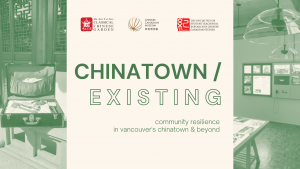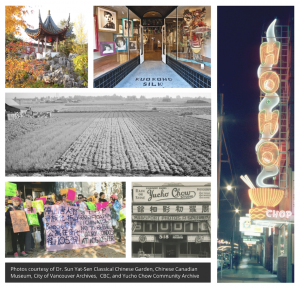This past summer, I had the opportunity and pleasure to work alongside Andrew Sandfort-Marchese, Shirley Ting, and Emma Quan to develop a field trip program for Grades 9-10 students in partnership with the Chinese Canadian Museum (CCM) and Dr. Sun Yat-Sen Classical Chinese Garden (the Garden). With the help of museum coordinators, local teachers, and INSTRCC leadership, we were able to create Chinatown, Existing.

The project involved designing the field trip portion as well as pre and post visit lesson plans and activities. The field trip itself was to consist of a visit to CCM and the Garden in addition to a walking tour of Chinatown. And of course, being in the midst of a pandemic, we incorporated a virtual field trip option. For the lesson plans, it was important for us to provide resources that are free and/or publicly available for accessibility. One of the challenges we faced was in scoping the learning outcomes and connections to the BC curriculum, but thankfully we had a group of experienced educators on board who were able to remind us that we didn’t have to check every box on the curriculum.
To get started, the four of us spent a day in Chinatown together. As a docent for CCM, Andrew was more familiar with the area, and was able to show the rest of us around the museum and guide us around the surrounding streets. I even had the chance to taste – for the first time – the sweet and tangy comfort of a Hong Kong style baked rice at The Boss Bakery where we enjoyed our lunch with a milk tea.
After our own “field trip” to Chinatown, I came away with a deeper understanding of what was so special about the space. We wanted to build a field trip program that captured the many facets of Chinatown that are often left out of history textbooks; we wanted students to come away with a new perspective on Chinatown, one that honors its history without relegating the space and its community to the past.
Chinatown, Existing offers a wider scope of Chinese Canadian histories that demonstrate the many relationships people of Chinese descent have had and continue to have with Canada, from early migration to the present. While racial discrimination against Chinese Canadians plays a large role in Canadian history, their individual voices and stories of resilience are often left out of the historical narrative. With Vancouver’s Chinatown as the focal point, the endurance of Chinatown, through stories of food, community, and activism, will demonstrate Chinese Canadian resilience in the face of discrimination. Grounded in the four themes at the CCM’s A Seat at the Table exhibition – Food, Culture, Services, and Activism – the lesson plans are designed to help students and teachers connect histories of discrimination against Chinese Canadians with broader histories and legacies of discrimination against other marginalized groups in Canada. The pre-visit activities set the stage for a field trip centering stories of action and resilience that unsettle the depiction of Chinese Canadians as quiet victims of racism.

Working on this project was deeply meaningful to me. The way I approached this project was sort of as a gift to my younger self – what I wish I could have learned about in high school. Moreover, being entrusted with developing this program, and being given a healthy balance of freedom and support from Henry, Denise, and Jenny, helped me to build confidence in my ideas and my abilities. And along the way I learned a lot of cool stuff about Chinatown, and ate some yummy food!
I’m proud to have worked on this project and grateful to have been given the opportunity. It brought me genuine joy to hear that Chinatown, Existing had its first successful run a couple of months ago and I look forward to seeing how it evolves in the future.
→ Visit the Chinatown, Existing website
Written by Moira Henry
 Faculty of Art
Faculty of Art